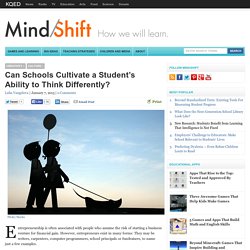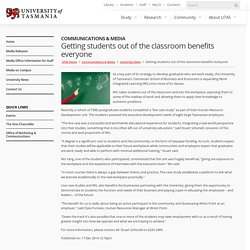

Can Schools Cultivate a Student’s Ability to Think Differently? Entrepreneurship is often associated with people who assume the risk of starting a business venture for financial gain.

However, entrepreneurs exist in many forms: They may be writers, carpenters, computer programmers, school principals or fundraisers, to name just a few examples. What they have in common is an “entrepreneurial mindset” that enables them to see opportunities for improvement, take initiative and collaborate with others to turn their ideas into action. Everyone is born with some propensity for entrepreneurship, which at its core is about solving problems creatively, according to Yong Zhao, a professor at the University of Oregon’s College of Education. He is the author of several books, including, most recently, “Who’s Afraid of the Big Bad Dragon? Why China has the Best (and Worst) Education System in the World.” “Students are treated like employees of a big company, who don’t bear the risk if the company fails,” he says. The Path From Here to There Related. 10 Specific Examples Of Emerging Educational Technologies. For over a decade, the New Media Consortium (NMC) has been charting the landscape of emerging technologies in teaching, learning, and creative inquiry on a global scale.

The NMC’s advisory board includes 750 technology experts and faculty members from colleges and universities in 40 countries, and is supported by the Consortium for School Networking (CoSN) and the International Society for Technology in Education (ISTE). The NMC’s latest research efforts, the NMC Horizon Report: 2013 K-12 Edition and the NMC Horizon Report: 2013 Higher Education Edition, were released this spring, and together highlight ten emerging technologies that will impact education over the course of the next five years: cloud computing, mobile learning, learning analytics, open content, 3D printing, MOOCs, virtual and remote laboratories, games and gamification, tablet computing, and wearable technology.
As an educator, you have probably heard about many of these technologies, if not all of them. 1. 2. 3. 4. 5. Getting students out of the classroom benefits everyone - Communications & Media - University of Tasmania, Australia. As a key part of its strategy to develop graduates who are work-ready, the University of Tasmania's Tasmanian School of Business and Economics is expanding Work Integrated Learning (WIL) into more of its classes.

WIL takes students out of the classroom and into the workplace, exposing them to some of the realities of work and allowing them to apply their knowledge to authentic problems. Recently a cohort of TSBE postgraduate students completed a "live case study" as part of their Human Resource Development unit. The students assessed the executive development needs of eight large Tasmanian employers. "The live case was a successful and worthwhile educational experience for students, integrating a real world perspective into their studies, something that is too often left out of university education," said Stuart Schonell, convenor of the course and avid proponent of WIL.
"A degree is a significant cost to students and the community, in the form of taxpayer funding. 11 Tips for Self-Education in the Internet Age. 195 23Share Synopsis If we are not actively curious, knowledge-seeking inquirers—we cannot hope to attain significant insight or understanding in any area of study.

Here are 11 ideas for an efficient and holistic approach to self-education. “Knowledge emerges only through . . . the restless, impatient, continuing, hopeful inquiry human beings pursue in the world, with the world, and with each other.” Paulo Freire A few weeks ago, I wrote an essay that decried the inadequacies of our mass education systems and made a case for an autodidactic approach to learning.
. “. . . I further suggested that whether one wishes to adopt such an attitude is one’s own prerogative, but I submitted that “in the face of mounting global crises and a rapidly evolving world, we need as many flexible, thoughtful minds as possible to navigate the complexity and develop a human-friendly, Earth-conscious future.” If you’re reading this, it’s likely that you’ve acquired such a curiosity. 1. 2. 3. 4. 5. 6. 7. 8. 9. 10.
11 Tips for Self-Education in the Internet Age. Online tools. Blogging. Gifted and talented education: using technology to engage students. Here we have collated some highlights and links from our recent live chat, in association with IGGY, that explored the role of technology in gifted education.

To read the discussion in full, click here. Jackie Swift (@jactherat), head of English at a London secondary school, was the G&T co-ordinator at her previous school and has blogged for the Guardian Teacher Network on gifted and talented pupils: Just what is gifted and talented? Do gifted and talented pupils need gifted and talented teachers? I agree that G&T students do need exceptional teachers, ones who don't feel threatened by them, who are open to being challenged beyond the usual and open to many things. Indeed a multi-subject specialist of some sort would fit the bill.
Tim Rylands' Blog - to baldly go....... Using ICT to inspire. Identifying gifted and talented students. Gifted and talented education: using technology to engage students.